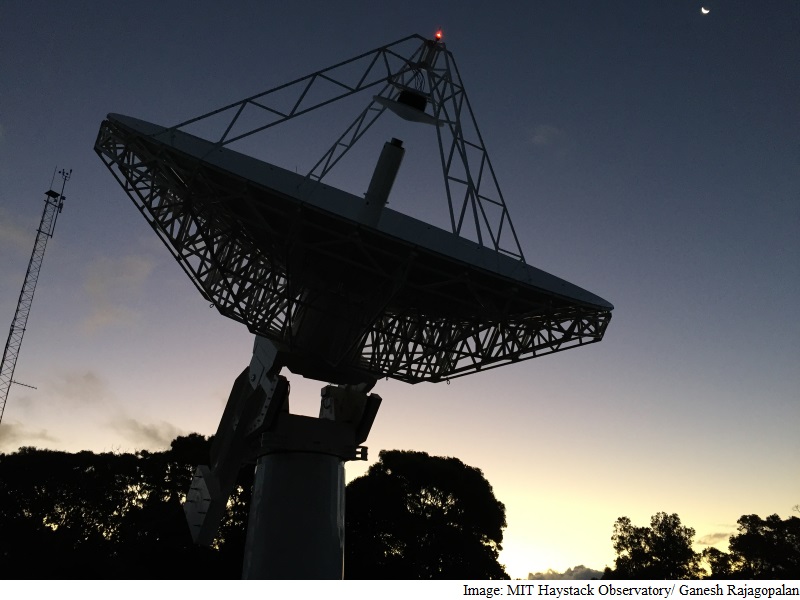- Home
- Science
- Science News
- Nasa's Global Observing System to Better Measure Earth's Orientation
Nasa's Global Observing System to Better Measure Earth's Orientation

The technology includes a new class of radio antenna and electronics that provide broadband capabilities for Very Long Baseline Interferometry (VLBI).
This technique has been used to make precise measurements of the Earth in space and time.
To meet the demand for more precise measurements, a new global network of stations called the VLBI Global Observing System (VGOS) is being rolled out to replace the legacy network.
Nasa just completed the installation of a joint Nasa-US Naval Observatory VGOS station in Hawaii.
Nasa has two other developmental VGOS stations operating at Nasa's Goddard Space Flight Centre in Greenbelt, Maryland, and at the Massachusetts Institute of Technology's Haystack Observatory in Westford, Massachusetts.
With this preliminary network, Nasa recently conducted the first demonstration anywhere in the world of broadband observations for VLBI over a long baseline.
"The successful tests demonstrate the viability of the new broadband antenna technology for making the kinds of observations needed for improved accuracy in measurements of the very fine-scale shape of Earth," said Benjamin R. Phillips, who leads Nasa's Earth Surface and Interior Focus Area.
Several technical hurdles had to be cleared to carry out the long-baseline demonstration.
One issue is that the effects of the ionosphere - a layer of Earth's upper atmosphere that impacts the behaviour of radio waves - and of the local weather are quite different at the three sites.
Another factor, which applies in any VLBI measurement, is that stations have to contend with interference from nearby radio and cell towers and other sources.
With the rollout of the VGOS network, existing VLBI stations are being replaced or upgraded.
More sites will be added in the future to provide more uniform coverage across the globe.
"The next-generation VLBI system will expand our ability to make the kinds of measurements that will be needed for geophysical studies and navigation applications, which demand more precision all the time," Nasa said in a statement.
For the latest tech news and reviews, follow Gadgets 360 on X, Facebook, WhatsApp, Threads and Google News. For the latest videos on gadgets and tech, subscribe to our YouTube channel. If you want to know everything about top influencers, follow our in-house Who'sThat360 on Instagram and YouTube.
Related Stories
- Galaxy S24 Series
- MWC 2024
- Apple Vision Pro
- Oneplus 12
- iPhone 14
- Apple iPhone 15
- OnePlus Nord CE 3 Lite 5G
- iPhone 13
- Xiaomi 14 Pro
- Oppo Find N3
- Tecno Spark Go (2023)
- Realme V30
- Best Phones Under 25000
- Samsung Galaxy S24 Series
- Cryptocurrency
- iQoo 12
- Samsung Galaxy S24 Ultra
- Giottus
- Samsung Galaxy Z Flip 5
- Apple 'Scary Fast'
- Housefull 5
- GoPro Hero 12 Black Review
- Invincible Season 2
- JioGlass
- HD Ready TV
- Laptop Under 50000
- Smartwatch Under 10000
- Latest Mobile Phones
- Compare Phones
- Huawei Pura 70 Pro
- Huawei Pura 70
- Vivo V30e
- Itel Super Guru 4G
- Huawei Pura 70 Pro+
- Huawei Pura 70 Ultra
- Tecno Camon 30 Premier 5G
- Motorola Edge 50 Fusion
- Asus ZenBook Duo 2024 (UX8406)
- Dell Inspiron 14 Plus
- Realme Pad 2 Wi-Fi
- Redmi Pad Pro
- Cult Shock X
- Fire-Boltt Oracle
- Samsung Samsung Neo QLED 8K Smart TV QN800D
- Samsung Neo QLED 4K Smart TV (QN90D)
- Sony PlayStation 5 Slim Digital Edition
- Sony PlayStation 5 Slim
- Voltas 1.5 Ton 3 Star Split AC (183 Vectra Elegant 4503545)
- Hitachi 1.5 Ton 5 Star Inverter Split AC (RAS.G518PCBISF)

















